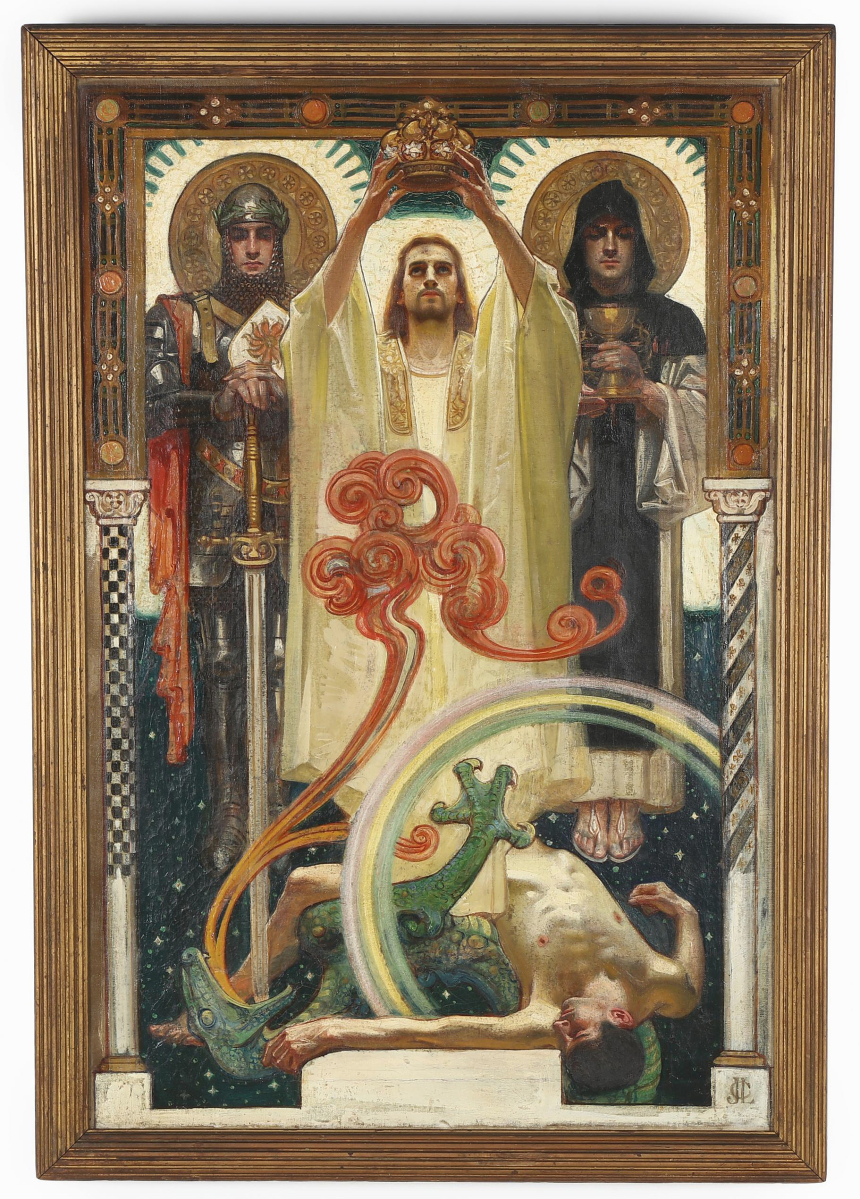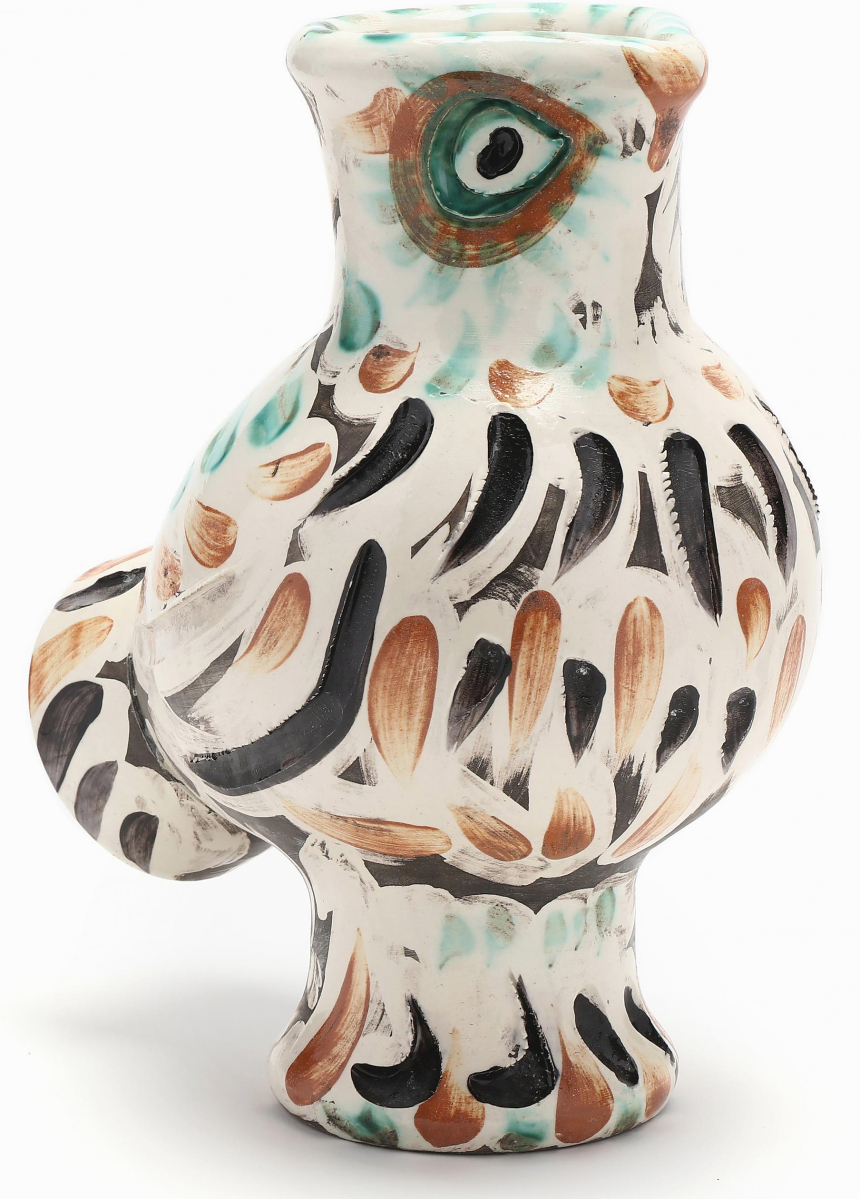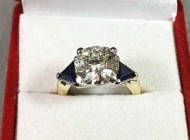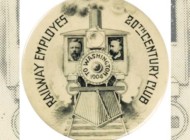
Bringing the sale’s top price of $88,800 was “Christ with Sainted Knights” by Joseph Christian Leyendecker (American, 1874-1951), oil on canvas, 32¾ by 22½ inches framed and monogramed lower right. Bidders on seven phone lines pursued the newly discovered work, which sold to an East Coast phone bidder who outbid an online bidder ($10/20,000).
Review by Madelia Hickman Ring, Catalog Photos Courtesy Leland Little Auctions
HILLSBOROUGH, N.C. – A recently discovered original work by illustrator Joseph Christian Leyendecker (American, 1874-1951) blew its estimate out of the water, closing at $88,800 and more than four times its high estimate after heated bidding from seven phone bidders as well as online competition. An East Coast buyer, bidding on the phone, triumphed over an online bidder to take “Christ with Sainted Knights;” it was the top price at Leland Little Auctions’ “Signature Spring Sale” on Saturday, March 13.
“It’s always nice when the director at any company finds a good object, does the research and gets a good result. Claire Frasier did just that with the Leyendecker,” company president Leland Little said in a shout-out to his fine art director. “Our Signature sales always get a lot of interest and enthusiasm so I am particularly pleased that the total was about 20 percent higher than we thought it would be.”
The sale of 306 lots made a total of $1.32 million with a sell-through rate of more than 88 percent. Bids were taken via phone and absentee, with three online platforms streaming the sale. Little noted an increase of about 18 percent in new bidder registrations in recent sales, comparing that to an average of ten percent increases during pre-pandemic sales.
_flower_girl_old_paris.jpg)
“It was gorgeous, just stunning. There was great depth and detail in the picture,” fine art specialist Claire Frasier said of “Flower Girl, Old Paris” by Louis Marie de Schryver (French, 1862-1942). It had been consigned from a private North Carolina collector but will be leaving the state having sold to a phone bidder from California for $43,200 ($20/40,000).
The Leyendecker was consigned to the auction house in January by a local picker who discovered the work in a country estate sale in South Carolina. It had previously been unknown to scholars and the auction house staff consulted Leyendecker expert, Kent Steine, who is the author of The J.C. Leyendecker Collection, for assistance in cataloging the work. Done in oil on canvas in a period giltwood frame, the work measured, overall, 32¾ by 22½ inches. According to the catalog note, Leyendecker did nearly 325 covers for the Saturday Evening Post, as well as other magazines such as Collier’s and Ladies’ Home Journal.
The image, the catalog noted, “is an intriguing combination of religious and Arthurian iconography.” A figure of Christ anchors the composition, flanked behind by Parzival and a monk holding the Holy Grail, all of which stand over the slain figure of a man and dragon, imagery that references the triumph of good over evil. Though the work was not dated, the catalog noted it was likely early in the artist’s career, made around 1900. Several factors were given to the reasoning for this date range, specifically the use of columns to frame the composition and the style of the artist’s monogram found in the lower right corner. The catalog presumed, because of the symmetrical design of the painting, that it had been designed for use as a magazine cover or book frontispiece but, to date, this has not been identified.
Claire Frasier liked “Flower Girl, Old Paris” by Louis Marie de Schryver (French, 1862-1942) so much that she had hung it in her office prior to the sale. Done in 1899 in oil on canvas, it was framed in possibly its original gilt composition frame that measured 34 by 28 inches. De Schryver was apparently one of the youngest artists to exhibit in the Nineteenth Century Salons, beginning at the precocious age of 13. His early works focused on scenes of contemporary life but by the end of the century, he had shifted his focus to depicting imagery of Eighteenth Century Parisian life; “Flower Girl” reflects that change in his career. The painting had come from a private collection in North Carolina but after considerable bidding, it sold for $43,200 to a private collector in California who was bidding on the phone. It was the second highest price in the sale.

A trade buyer, bidding online, paid $30,000 for “Chouette” by Pablo Picasso (Spanish, 1881-1973). It was dated 1969 and marked “Madoura Plein Feu / Edition Picasso / Edition Picasso / Madoura / 249/350” ($8/12,000).
Five Pablo Picasso Madoura ceramics and some books on Picasso lithographs were from the Chapel Hill, N.C., collection of Helaine Plaut; all of the lots sold with two of the ceramics achieving particular noteworthy results. Bringing $30,000 from a trade buyer bidding online was “Chouette,” an owl-form vase, number 249 from an edition of 350, while another online bidder paid $20,400 for “Lampe Femme,” which dated to 1955 and was one of just 200 made. Frasier said they had received a great amount of presale interest in all of the Picasso works, selling to “lots of different buyers.”
Approximately one-third of the sale was jewelry and several lots achieved top-tier prices. Leading the category was a platinum and diamond ring with three stones, the central one of G color and VS1 clarity weighing 1.5 carats flanked by two .90 carat diamonds, each of F color and VS2 clarity that had been made by Arthur Groom & Co. of New Jersey. Nancy Blount, Leland Little jewelry director, said “three-stone rings are really timeless; the quality of consistency of the stones, which were perfectly symmetrical, really set that off.” It sold to a phone bidder for $16,800, more than doubling its low estimate.
The sculptural gold jewelry of modern designer Jean Mahie was represented by three lots in the sale, all from the same private Raleigh, N.C., collection. Blount said that the sculptural quality and deep patina of Mahie’s pieces typically attract international interest. Bringing the most money of the three was a 22K gold link necklace, measuring 22 inches long, that sold to a phone bidder for $13,200. A cuff bracelet sold to a phone bidder for $10,800, while the 22K link bracelet, which was a match to the necklace, achieved $5,520.
Men’s luxury watches have been a hot collecting category in recent years, though ladies’ watches have been a soft side to that trend. It is nice to see a Patek Philippe lady’s stainless steel and diamond “Aquanaut Luce” watch, which had been acquired at Tiffany & Co., in 2010, bring $15,000 from an online bidder with underbidders on the phone.
_after_the_party.jpg)
Interest in “After the Party” by Andy Warhol (American, 1928-1987) was widespread but competition for the 1979 colored screenprint was all online. It danced to $24,000 ($8/12,000).
Leland Little has been developing its photography department and reaped the benefits of that in the result achieved for “Preparatory Photograph for Candy Cigarette” by Virginia-born photographer Sally Mann (b 1951), which Frasier called “an iconic image.” The silver gelatin contact print, circa 1989, which bore a handwritten letter from Mann to the Tartt Gallery of Washington, DC, brought $16,800 from a New York City buyer. Frasier thought that several recent exhibitions of Mann’s works have increased visibility and interest in the artist, which likely helped contribute to the sale result.
Works of Confederate interest and appeal were led by a tintype of a Confederate surgeon that sold to a Virginia phone bidder for $15,600, more than five times its high estimate. The sitter had been identified as assistant surgeon William R. Hugest, from the 31st North Carolina infantry and was shown wearing a short gray military jacket with straps and lapels while holding a standard-issue M1850 officer’s sword. The buckle on his belt was marked “NC,” and is apparently seen in Civil War photos. The photo had come from the Durham, N.C., estate collection of Dr Joseph C. Greenfield Jr. A set of four sixth-plate ambrotypes depicting four members of the John Favor family of Fayetteville, GA., were also from the Greenfield collection and brought $8,400.
A handful of pieces of Southern furniture crossed the block, led by a Federal inlaid mahogany Pembroke table that had been attributed to Eastern Virginia, circa 1800, that sold to a Virginia buyer for $10,200. It was followed by a Federal inlaid cherry sugar chest that brought the sweet price of $7,200 and a Federal inlaid sideboard that sold within estimate for $3,480. Also selling within estimate was a Federal walnut inlaid chest of drawers for $1,800 and a Classical carved mahogany sideboard at $1,200. Little said it was all purchased by buyers in North Carolina, Virginia or Georgia.
Leland Little Auctions’ next Signature sale will take place in June.
Prices quoted include buyer’s premium as reported by the auction house.
For information, 919-644-1243 or www.lelandlittle.com.


_untitled.jpg)

_the_old_wharf.jpg)







_preparatory_photograph_for_candy_cigarette.jpg)
_lampe_femme.jpg)
_tower_with_birds_and_butterflies.jpg)

_flower_girl_old_paris.jpg)
_after_the_party.jpg)




